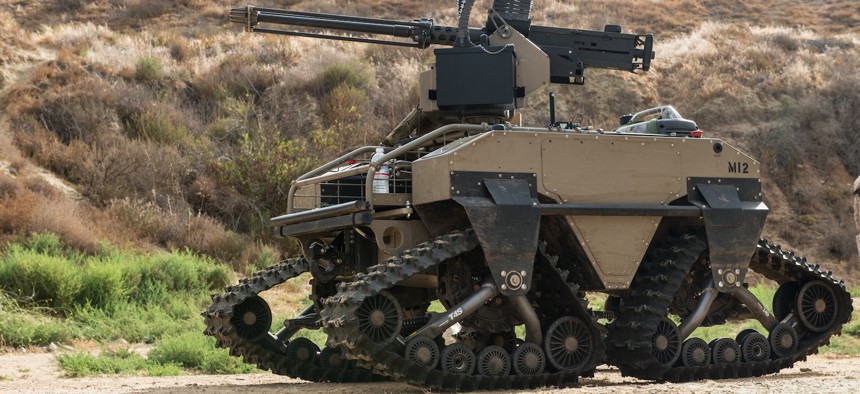
Marines with 3rd Battalion, 5th Marine Regiment tested new equipment such as the Multi Utility Tactical Transport in a simulated combat environment at Marine Corps Base Camp Pendleton, Calif., July 8, 2016 Photo by Lance Cpl. Julien Rodarte / 15th Marine Expeditionary Unit
Self-Driving Cars Could Soon See Much Better
Advances in laser range-finding could enable much smarter smart vehicles.
Self-driving vehicles, including the ones that the U.S. military is experimenting with, are still pretty bad at picking out small details as they move through the world, a limitation of the Light Detection and Ranging, or LIDAR, systems they use to perceive it. But a new technique that uses the peculiar behavior of photons to boost LIDAR resolution may allow such vehicles to better understand their surroundings—and even to recognize people and objects.
A LIDAR-equipped car bounces laser pulses off everything around it—other cars, curbs, trees—then measures the time these pulses take to return and uses the data to gauge things like distances and shapes. But the sharpness of LIDAR’s vision falls off as it begins to move.
Researchers from the University of Glasgow have developed a technique that greatly improves how well LIDAR can perform in a setting with lots of motion interference. As they describe in their peer-reviewed paper, published this week, the method takes advantage of the peculiar behavior of photons when they encounter a beamsplitter, which is used to split a single laser beam into two.
“When the photons meet at the beamsplitter they will [usually] stick together, or ‘bunch’ because of interference,” Ashley Lyons, research fellow and proleptic lecturer at the University of Glasgow’s School of Physics and Astronomy (Extreme Light Group,) told Defense One in an email. “Let's say you have an object 10m away, if I set the reference arm of my interferometer to be exactly the same distance I will see the photons interact and preferentially ‘bunch’ together. If the reference arm is set to any other distance nothing will happen and the photons will act independently. Essentially we scan possible delays in the reference arm where we think there might be an object and look for this bunching behavior.”
That technique results in much better LIDAR images, able to pick out even facial features on small coins, according to the researchers’ experiments. That could imbue future self-driving vehicles with the ability to do facial recognition (without calling back to a database of faces stored elsewhere.)
“This enhanced resolution opens up avenues for LiDAR in 3D facial recognition and small feature detection/tracking as well as enhancing the capabilities of more complex time-of-flight methods such as imaging through obscurants and non-line-of-sight imaging,” they write.
Right now, says Lyons, the form factor is a bit too large to fit on a vehicle but the largest component is the femtosecond laser. The fast-moving field of fiber lasers could shrink the laser considerably in the years to come.
The U.S. Army has been increasing experiments with LIDAR-equipped self-driving vehicles and plans to deploy an optionally-manned fighting vehicle by 2030. Since LIDAR can be detected and targeted by adversaries, the Army is looking for alternative means of sensing. Still, LIDAR might still be a feature on ground vehicles in combat, especially if the robots can be manufactured cheaply enough and in such numbers that detection wouldn’t matter—since they would still be able to swarm an adversary.
Vehicles with better LIDAR could also play a larger role in intelligence or reconnaissance collection, especially in situations where it might be too dangerous to send a human, and where flying drones might attract attention.
NEXT STORY: US Navy Prints Metal Parts on the High Seas




